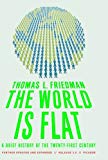
The World Is Flat is a book by Thomas Friedman discussing the trends of globalization in the 21st century. Friedman describes himself as a "free-trader," arguing in favor of the rapid shifts towards a more interconnected economic world after the fall of the USSR as a result of the Internet, computers, outsourcing and workflow software. Friedman also presents his controversial Dell Theory of Conflict Prevention: that corporations' increased dependency on foreign labor and resources will prevent armed conflict.
As we are introduced to Friedman’s theory that the world is flat, we accompany him on a journey to the various locations around the globe that led him to this conclusion. We start off in Bangalore, India, where he finds himself surrounded by advertisements of traditionally American companies such as Pizza Hut, Epson, HP and Texas Instruments during a round of golf. Traveling with a crew from the Discovery Times channel, he encounters Indian workers and businesspeople working for American companies, speaking in American accents and even adopting American names in their own country. A visit to Infosys Technologies Ltd leavesFriedman in wonder at the massive conferencing system they have created that allows people from around the globe to congregate and collaborate in one giant room via satellite and teleconferencing technology.
Friedman guides us through the different eras of globalization as he has defined them in an historical narrative from the days of Columbus to our present day state. We see the ever increasing pace of globalization through his encounters with people such as Jaithirth“Jerry” Rao, an outsourced businessman in India, and others. Through Jerry, we learn about the process of information exchange online and the effect it has on businesses to perform various duties from remote locations with everything from tax preparation to hair appointment scheduling to hospital bookings cited as examples of outsourcing.
As Friedman travels through Japan, China and back to America, we study various examples of the business outsourcing phenomenon and its impact, positive and negative, on the players involved. Homesourcing and military outsourcing are explored as Friedman explains the sheer prevalence of outsourcing in our society.
Already have an account? Log In Now